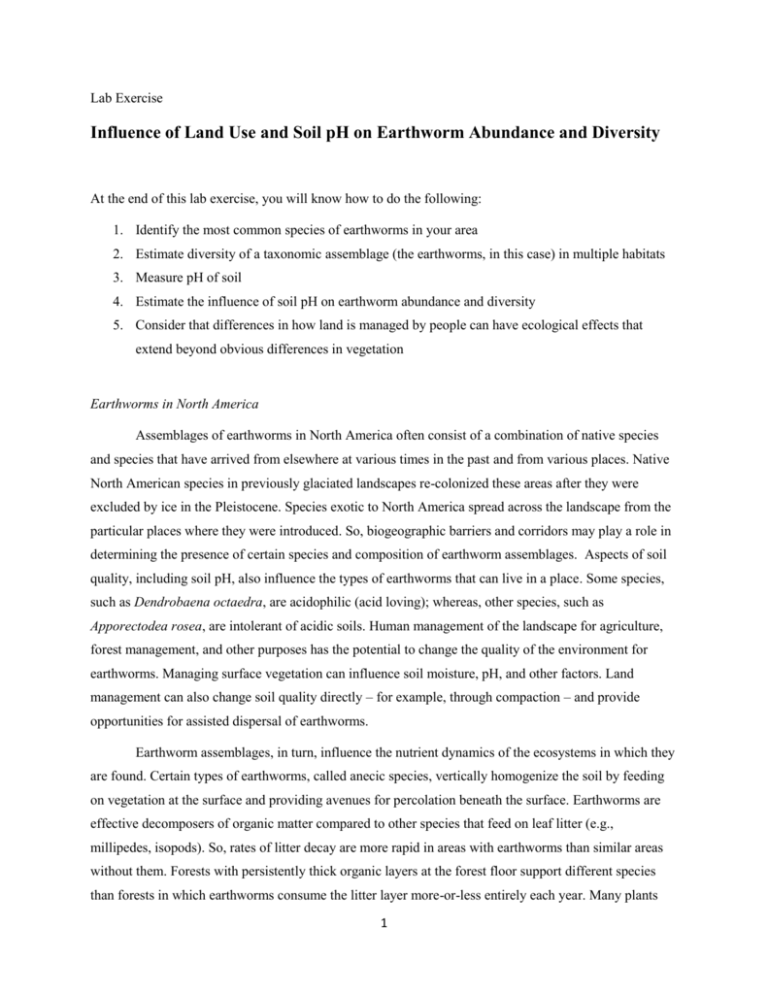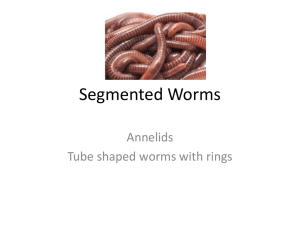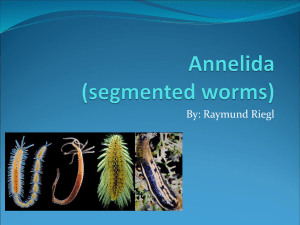EREN Earthworm Lab Exercise
advertisement

Lab Exercise Influence of Land Use and Soil pH on Earthworm Abundance and Diversity At the end of this lab exercise, you will know how to do the following: 1. Identify the most common species of earthworms in your area 2. Estimate diversity of a taxonomic assemblage (the earthworms, in this case) in multiple habitats 3. Measure pH of soil 4. Estimate the influence of soil pH on earthworm abundance and diversity 5. Consider that differences in how land is managed by people can have ecological effects that extend beyond obvious differences in vegetation Earthworms in North America Assemblages of earthworms in North America often consist of a combination of native species and species that have arrived from elsewhere at various times in the past and from various places. Native North American species in previously glaciated landscapes re-colonized these areas after they were excluded by ice in the Pleistocene. Species exotic to North America spread across the landscape from the particular places where they were introduced. So, biogeographic barriers and corridors may play a role in determining the presence of certain species and composition of earthworm assemblages. Aspects of soil quality, including soil pH, also influence the types of earthworms that can live in a place. Some species, such as Dendrobaena octaedra, are acidophilic (acid loving); whereas, other species, such as Apporectodea rosea, are intolerant of acidic soils. Human management of the landscape for agriculture, forest management, and other purposes has the potential to change the quality of the environment for earthworms. Managing surface vegetation can influence soil moisture, pH, and other factors. Land management can also change soil quality directly – for example, through compaction – and provide opportunities for assisted dispersal of earthworms. Earthworm assemblages, in turn, influence the nutrient dynamics of the ecosystems in which they are found. Certain types of earthworms, called anecic species, vertically homogenize the soil by feeding on vegetation at the surface and providing avenues for percolation beneath the surface. Earthworms are effective decomposers of organic matter compared to other species that feed on leaf litter (e.g., millipedes, isopods). So, rates of litter decay are more rapid in areas with earthworms than similar areas without them. Forests with persistently thick organic layers at the forest floor support different species than forests in which earthworms consume the litter layer more-or-less entirely each year. Many plants 1 germinate within the litter layer and animals use the litter layer as a three-dimensional habitat. Because of their ability to change the quality of the environment for so many other species, earthworms are sometimes referred to as “ecosystem engineers.” This lab exercise will give you a sense for the abundance and diversity of earthworms in the local landscape. You additionally will measure soil pH and sample in different habitats to get a sense for some of the factors that can affect the presence and abundance of earthworms. WEEK 1: FIELD SAMPLING AND INITIAL PROCESSING OF SAMPLES Sample Locations You will select several locations that differ dramatically in land use. Consider selecting (1) an intensively managed forest, such as a conifer plantation, (2) an intensively used, small forest, such as an urban woodlot, and (3) a forest that has been protected from intensive use, such as a remote forest within a protected area. Intensively used forests, especially those near human settlements, may have had greater opportunity to be colonized by exotic earthworms. Sampling Earthworms Once habitats (e.g., a woodlot) have been selected for sampling, the specific locations of quadrat placement should be chosen randomly (or at least arbitrarily) to avoid bias due to micro-habitat. Consider tossing a tennis ball or something else into the site to determine the exact location for the central point of the sampling arrangement. Mark the determined central point using a stake flag or something similar. You will sample three 0.36-m2 quadrats around each center point. Place quadrats 5 meters from the central point toward the bearings 0°, 120°, and 240° as illustrated in the diagram to the right. At these quadrat locations, place the 0.6 m × 0.6 m sampling frame. You will sample earthworms with a technique called mustard vermifuge. Basically, a spicy mustard solution is applied to the soil. It irritates the integument of earthworms, which stimulates them to emerge from their burrows. To make one dose of the solution, add 60 g ground hot mustard seed powder to 6 liters of water and mix well. Two doses of 6 liters are required for each 0.36-m2 sample quadrat. You will prepare mustard solution in the field immediately before use by mixing 6 liters of water and a pre-measured bag of mustard powder in a bucket. 2 Clip all vegetation and manually remove loose leaf litter from the location of your quadrats. At each sample quadrat, apply the first dose of the solution to the area within the frame. Pour the solution slowly, allowing it to infiltrate the soil. Wait and watch for 5 minutes, collecting any worms that emerge. Pour a second dose of the solution and wait another 5 minutes. Quadrats on steep slopes present challenges because of the tendency for the solution to run off rather than infiltrate. The solution must be applied very slowly in these cases. The sample frame can be solidly pressed against the ground (e.g., by standing on it) to prevent runoff. Earthworms should be collected with fingers or flat forceps. Wait for worms to completely emerge to avoid damage to the animals or scaring them underground and missing them. This is especially important for Lumbricus terrestris, the common night crawler. In the field, earthworms can be placed in labeled plastic cups along with moist paper towels. If the weather is hot, containers should be stored in a cooler on ice until return to the lab. Sampling Soil Use the soil corer provided to take a sample of the top 10 cm of soil for estimation of soil pH. Take one soil core near each of the three quadrats used to sample earthworms. Be sure to clear away leaf litter from sampled locations. These soil cores can be placed together in a labeled “whirl-pack” and returned to the lab. In the lab, soil samples should be homogenized (thoroughly mixed), “screened” (rubbed through a ~ 2 mm mesh filter), and left in a labeled pan to air dry. Stabilization and storage of worms In the lab, earthworms should be examined alive and described as fully as possible. Special note should be made about color, which will change after preservation. Try to determine whether your earthworm has surface pigmentation, and if so describe the color. (Earthworms without surface pigmentation have “a color” nevertheless because of vascularization and other internal features.) Photographs should be taken, if possible. Can you count the segments of your earthworm? If so, how many are there in front of the clitellum? Can you see your earthworms’ hearts beating? To make or confirm specific determinations, worms will have to be sacrificed and preserved. This is a three-step process: 1. Euthanasia.—Worms should be killed by immersing them in dilute 10% isopropanol until immobile. (This should just take 1-2 minutes.) 2. Fixation.— Worms should be transferred to 10% buffered formalin for tissue fixation. Environmental health precautions must be taken with formalin. This is an important step in “tightening” the surface features that will be important to identification. 3 3. Preservation.—After at least 2 days in the fixative, animals should be rinsed with distilled water and placed in 70% isopropanol. Your instructor will complete this step in between lab meetings. These steps can be performed in labeled, plastic centrifuge tubes with screw-top lids. Give each earthworm a unique ID number (e.g., “BDSE-16”, where BDSE is the name used to identify the site and 16 is the unique sequential number of the specimen). Record the number on copies of the following data sheet along with notes taken from life. (Make copies of this form as needed.) 4 Identification Data Form Unique Site Code: __________ Unique ID Notes from Live Specimen Notes from Preserved Specimen Page ___ of ___ 5 Length (mm) Taxon (sp. code) Identification Data Form (instructions) Unique ID – Each animal sampled should be given a separate number and row on the data form. If more than 20 animals are collected, multiple forms should be used. Notes from live specimens – notes regarding morphological characters observed while the animal is alive. See short-hand abbreviations below. Notes from preserved specimens – notes regarding morphological characters observed after the animal has been preserved. Length – length to the nearest mm of the animal after preservation. The animal should be straightened but not stretched when taking measurements. Taxon – species or other taxonomic determination; use a four-letter species code constructed of the first two letters of the genus and first two letters of the specific epithet. Keep track of these codes. Short-hand abbreviations: Pigmented = PIG; Unpigmented = UPG Clitellum = CL (use Roman numerals to indicate segments) Epilobic = EPL; tanylobic = TNL; prolobic = PRL; zyglobic = ZGL Widely-paired setae = WPS; closely-paired setae = CPS; separate setae = SPS; bristle-like setae = BLS Tuberculata pubertatis = TP Genital tumescence = GT Male pore = MP; female pores = FP 6 WEEK 2: EARTHWORM IDENTIFICATION, DETERMINATION OF SOIL PH, AND DATA ANALYSIS Earthworm Identification You will be provided with a key from Reynolds (1977) and a field guide by Hale (2007). If you have limited experience with dichotomous keys, your instructor may demonstrate. You should methodically work through the preserved earthworms, determining them to the best of your ability using the keys provided. Spend time learning the names used to describe earthworm morphology using the glossary provided. You will need to use a dissecting microscope to see most of the characters. The fixative causes the earthworms to lose their natural color and appear white to varying degrees. So, you will need to use your notes “from life” in answering questions about color. Once earthworms are identified, summarize the data by site and taxon on the sheet at the end of this section. Soil pH Starting with the air-dried soil in your labeled pans, follow this protocol1 to measure soil pH. There is some “down time” in the middle of this protocol. So, you will want to start this at the beginning of the lab period and make use of the down time completing other tasks (e.g., identifying earthworms). 1. Weigh out 10 g of soil and place it in a 30 ml beaker; 2. Add 20 ml of deinonized/distilled water; 3. Stir vigorously about once every 5 minutes for 30 minutes; 4. Let stand about 1 hour; and 5. Immerse electrode of a calibrated pH meter into the supernatant and record. Simultaneously conduct this analysis on three subsamples from your homogenized soil sample and record below. Subsample 1 ________, Subsample 2 ________, Subsample 3 ________, Calculate the average of these three pH values as a measure of the pH for your site. But, hold on! Because pH is on a logarithmic scale, we cannot use the simple average. Recall from basic chemistry that 𝑝𝐻 = − log10[ 𝐻 + ], where H+ is the concentration of hydrogen ions in solution So, to calculate the average of several pH values, we first need to back-calculate H+ by solving the following for each of our pH values: H+ = 10-pH. Now, take the average of these hydrogen ion activities and, finally, take the log10 of this value to get the true average pH. Your instructor may illustrate these calculations using Excel. Enter your final average pH for each site to the sheet at the end of this section. 1 Protocol adapted from Hendershot et al. (1993) 7 Data Analysis As a first step in data analysis you should enter the data from the sheet at the end of this section into excel. Enter the data into rows and columns as they are presented in the sheet. Add a column to the spreadsheet that is the total number of earthworms collected, n. Do this using the =sum() function. Add another column to the spreadsheet that indicates the number of species recorded, S. Do this using the =count() function. Note that you should not include columns in this tally that include indeterminable earthworms, such as juvenile Lumbricus. You will calculate the diversity of earthworms from each of your samples. There are many indices that may be used to reflect the diversity of species in a sample. The simplest of these is species richness, which is most simply calculated as S = # species in the sample and that you already calculated above. However, species richness estimates are clearly affected by the number of specimens upon which they are based. For example, you can’t find more than two species in a sample of two individuals. So, often ecologists will standardize their estimates to the size of the sample. Perhaps the most common of these standardized estimates is Margalef’s Index, which is calculated as follows: 𝑆−1 𝑅 = ln(𝑛), where n and S are as defined and calculated above. Use an Excel function to calculate Margalef’s Index from your samples. (The natural logarithm function in Excel is =ln().) All estimates of species richness fail to account for the equitability, or lack thereof, of specimens among species in your sample. For example, a sample of 100 earthworms including 50 nightcrawlers and 50 oak worms is arguably more “diverse” than a sample of 100 earthworms including 99 nightcrawlers and 1 oak worm. There are many indices that are used by ecologists to reflect both species richness and equitability of species data. These are sometimes called indices of “true abundance.” A common measure is Shannon’s Index (H´), which is calculated as follows: 𝑛 𝑛 𝑛 𝑛 𝐻 ′ = − ∑𝑆𝑖=1 [ 𝑖 ln ( 𝑖)], where ni is the number of specimens collected for species i and n and S are as defined above. This is a bit trickier to calculate in Excel, but it is much easier to do in Excel than by hand! Add a column to your datasheet that indicates Shannon’s Index for each sample. Presentation Now work in groups to construct three figures and tables that “tell the story” of how soil pH and habitat influence earthworm abundance and diversity at these sites. Present these summaries of the data to the class and explain the relationships demonstrated in them. 8 Earthworm Summary Data Form Species Code Site pH Page ___ of ___ 9 Summary Data Form (instructions) Site – The unique name given to each site sampled. The three quadrats (subsamples) are combined to yield the data for a site. pH – Soil pH as determined using the protocol in this lab handout. Species Code – four-letter species code constructed of the first two letters of the genus and first two letters of the specific epithet. Keep track of these codes on the sheet provided. Make additional copies of this sheet if more than eight taxa are recorded at your sites. 10







